You don't want to do it, she doesn't want you to do it, but you have to do it. How to give your cat subcutaneous (sub Q) fluids to greatly improve their quality of life.
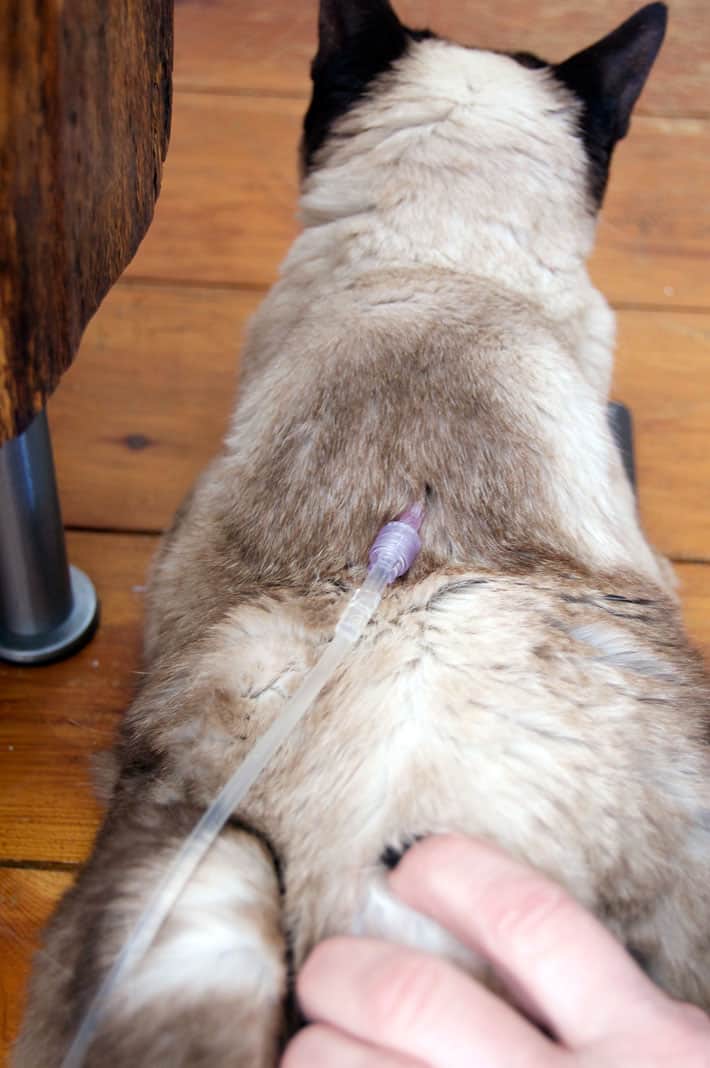
Meet Cleo. The cat I always thought was a Siamese but then found out is actually a Burmese but THEN found out is actually a Siamese. Confusing I know. My vet thought she was a Burmese for a while based on the shape of her head but we finally decided she was an applehead Siamese (also known as a traditional Siamese.)
Several years ago Cleo just seemed "off" so I took her to the vet. I found out Cleo had a dreaded cat disease. Chronic Renal Disease. Although vets insist on calling it "Chronic Renal Failure" which sounds much more ominous. When my vet told me this news my eyes grew to the size of pumpkins and welled up. I thought he was gently telling me little Cleo would be dead by week's end. She lived for another 2 ½ years before I made the decision to be in a horrific amount of pain so she didn't have to be.
Make no mistake about it, renal disease is ominous, but it doesn't necessarily mean your cat is going to drop dead within weeks or even months. With medicine and treatment Cleo lived a happy life for over 2 years after her diagnosis. But she wouldn't have without Subcutaneous Fluids.
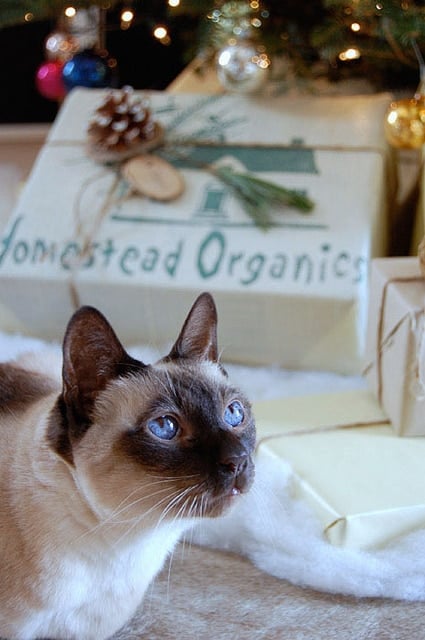
Renal Failure in cats means their kidneys aren't working at 100%. The worse the condition, the less the kidneys are working. A cat with chronic kidney disease will drink a lot and pee a lot. In fact they pee out so much of their fluids that they dehydrate themselves.
If you've ever been dehydrated you know how awful that feels.
One of the things you can do to make your elderly, chronic renal (kidney) disease cat happier and healthier is by giving them subcutaneous fluids. At home. By yourself. Even though you're terrified.
Your vet will let you know if this is a good option for you. Don't just go out willy nilly and start jabbing your cat with needles and filling them with fluids.
I did this every other day for about the last year of Cleo's life and after a somewhat inelegant introductory period, we both got quite good at it. We don't like it. But we get through it with as little pain and biting as possible now.
Why do it? When a cat gets to the end stages of chronic renal disease they don't feel well. But these fluids make them feel much better. So when the vet said I could do this for her at home I had a little fainting fit, tried to bite him and then asked him to show me how to do it. Her vet was Dr. Mark who you might remember from my chicken related Ask Dr. Mark posts.
Like I said, the first few tries were a bit of a shitshow, but Cleo and I got the hang of it.
Table of Contents
How to Give a Cat Subcutaneous Fluids
Remember, always use a new needle and keep your fluids at room temperature so it's more comfortable for the cat.
Materials
- Fluids
- 18-20 gauge needles.
- Hang your fluid bag a couple of feet higher than you will be with your cat. I used a coat hanger.
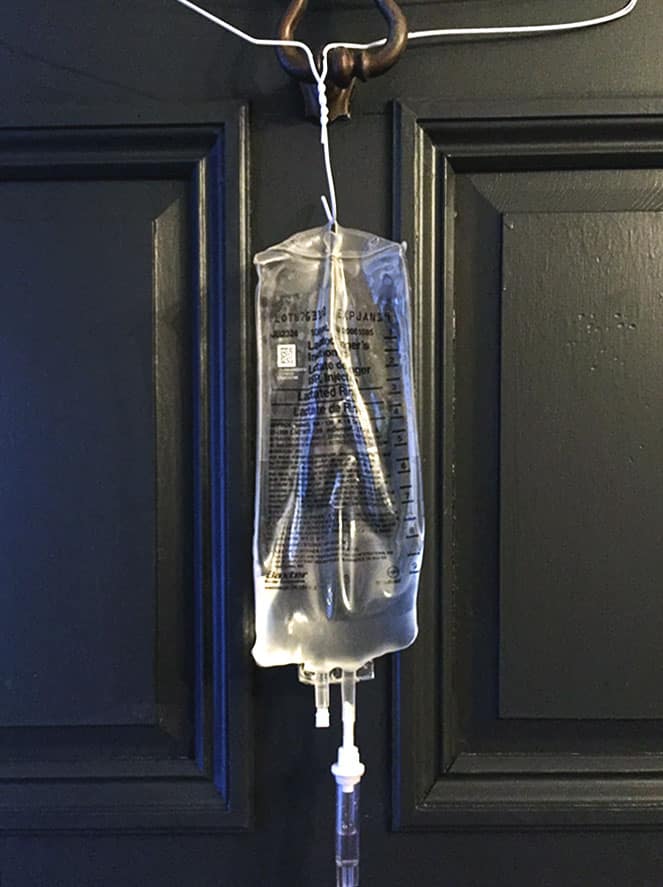
2. Remove the cap from the end of the tubing.
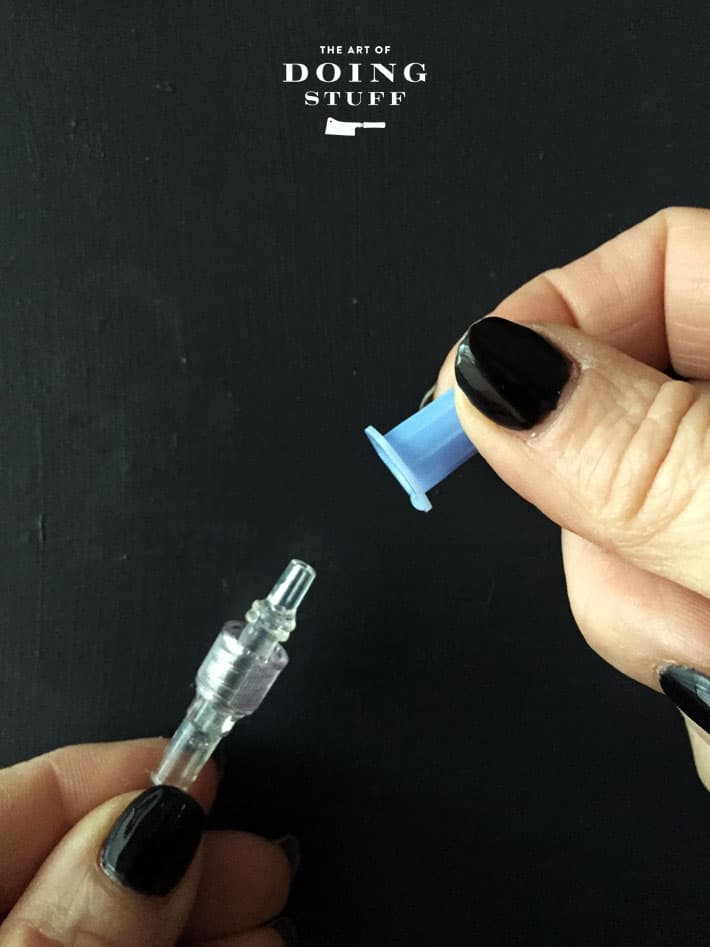
3. Press your needle (with the protective cap still on) onto the nub.
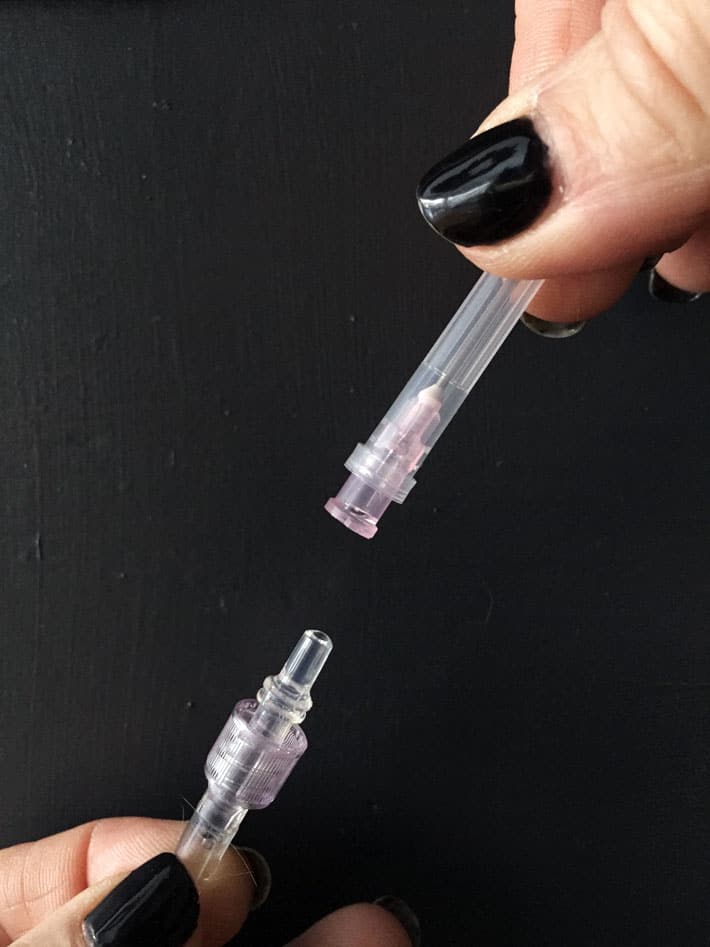
4. Twist the plastic nut a couple of twists to hold the needle in place.
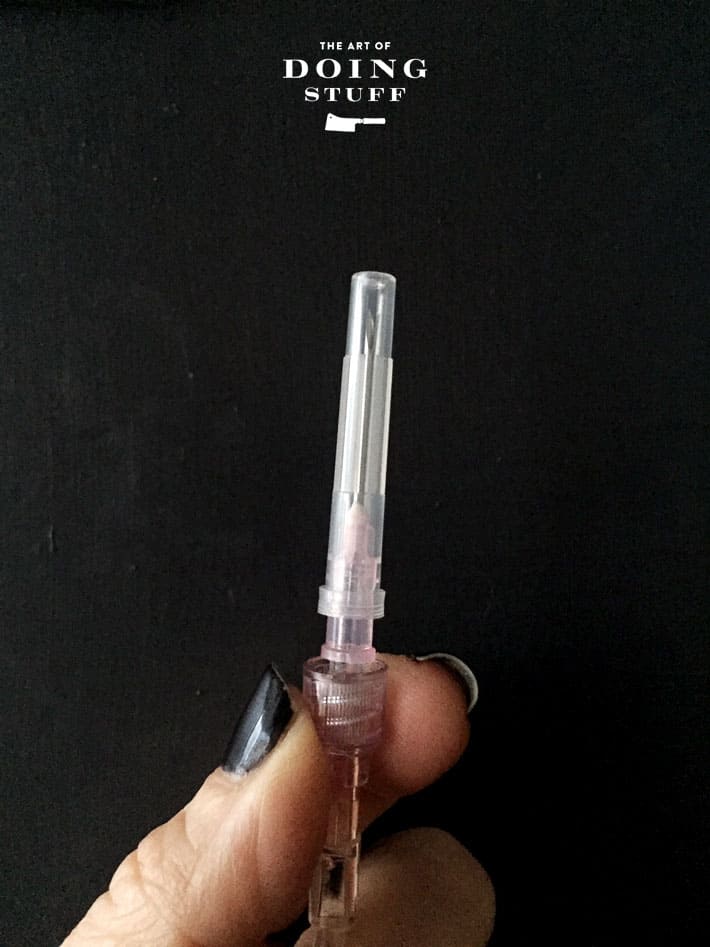
5. Remove the protective cap on the needle.
Needle Choice Options
You can use an 18-20 gauge needle on your cat.
- With the 18 gauge (which is larger) your fluid therapy will go more quickly.
- With a 20 gauge needle (which is smaller) it is less painful for the cat but will take longer to administer the fluids through the smaller hole.
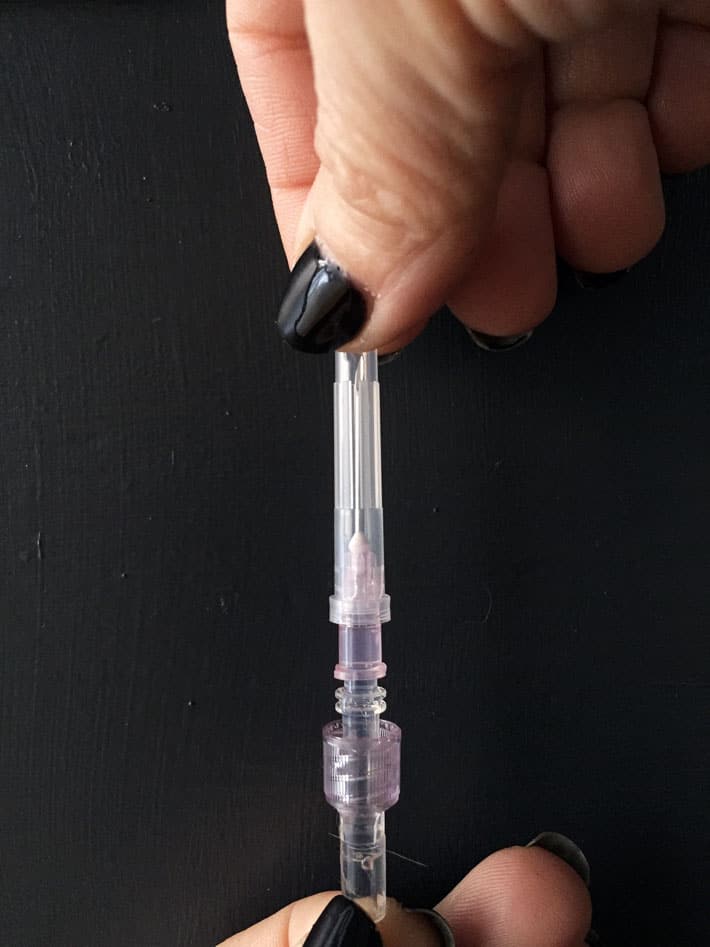
6. Find the open hole on the needle. This should be inserted facing up into the cat.
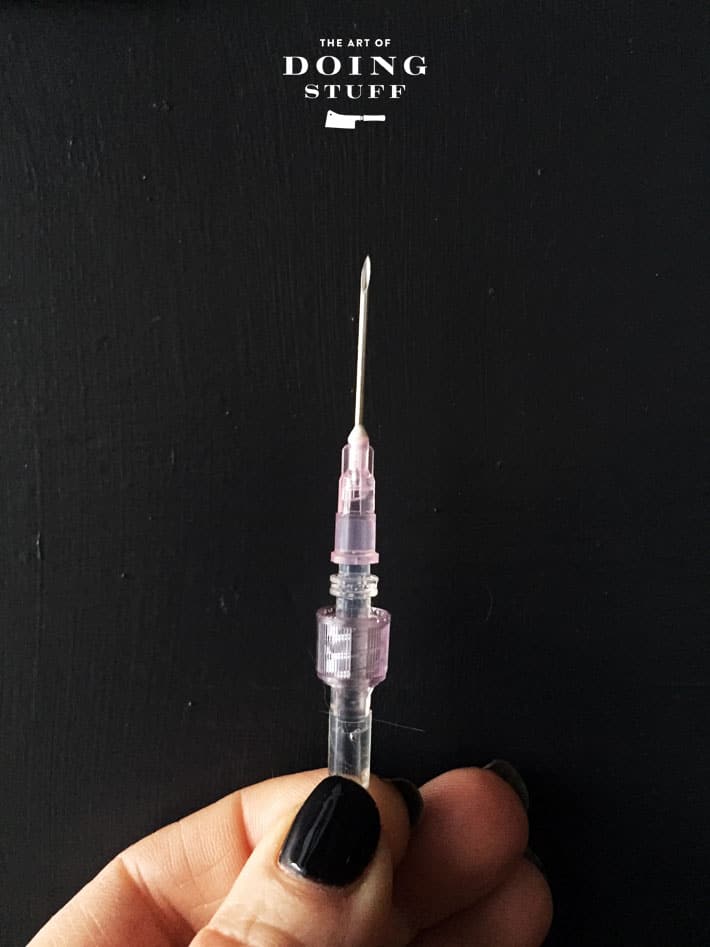
7. Put your cat where you'll both be comfortable. You'll need to keep your cat in place. I like to squish her between my legs on the floor near her favourite heating vent. Other people will sit their cat in the corner of a chair or couch to keep them from squirming away. Putting them in a very small box could work as well. Cats like boxes, they feel safe in them and it would help stop them from crawling away.
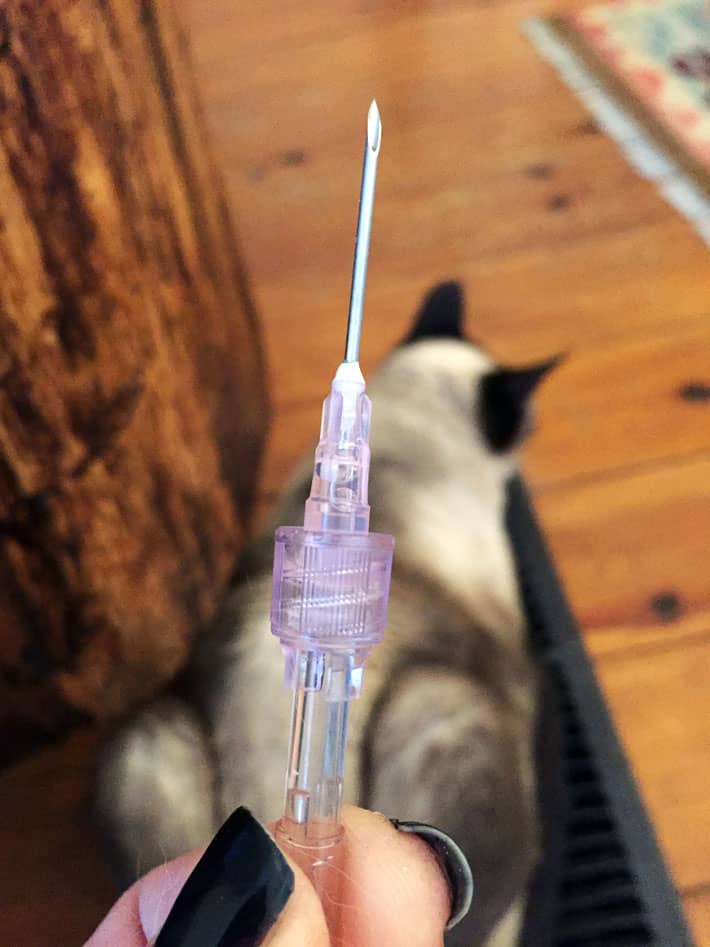
8. Hold the needle in your dominant hand with the hole facing up. With your other hand pull the cat's skin up by the scruff around her shoulder blades, forming a tent.
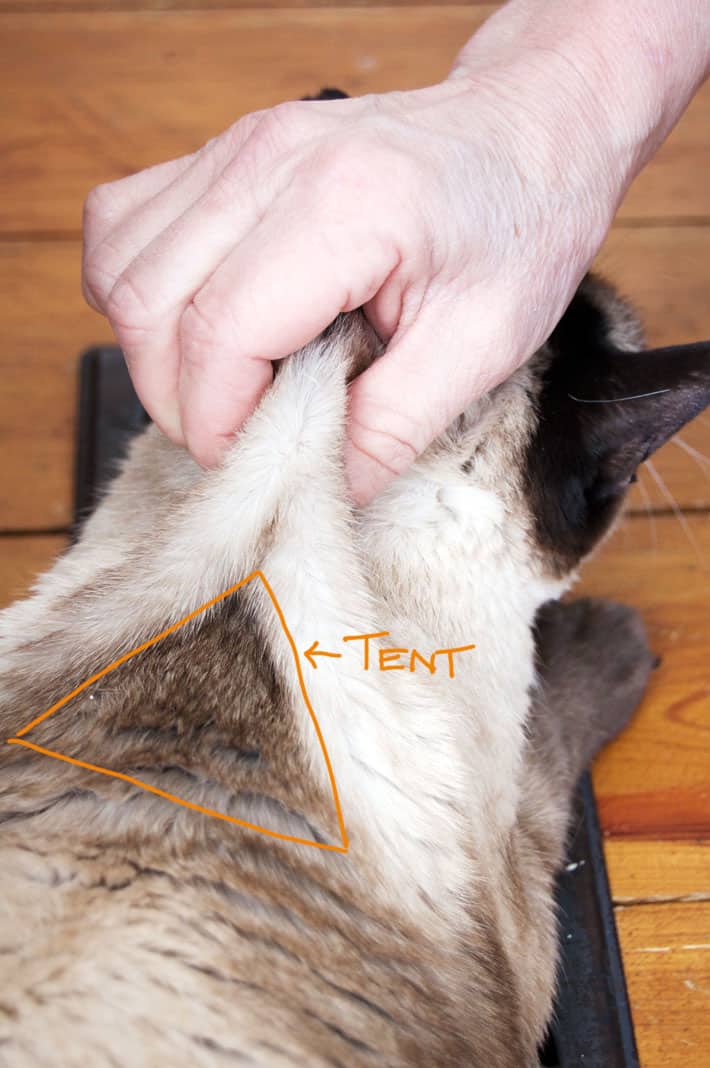
9. DECISIVELY insert the needle (with the hole side up) into the tent of skin. Don't hesitate. The first few times it'll be gross and scary and shocking and you'll hear the skin crunch and all sorts of awful things. You want the needle to go in the pocket of air between the skin and her muscle.
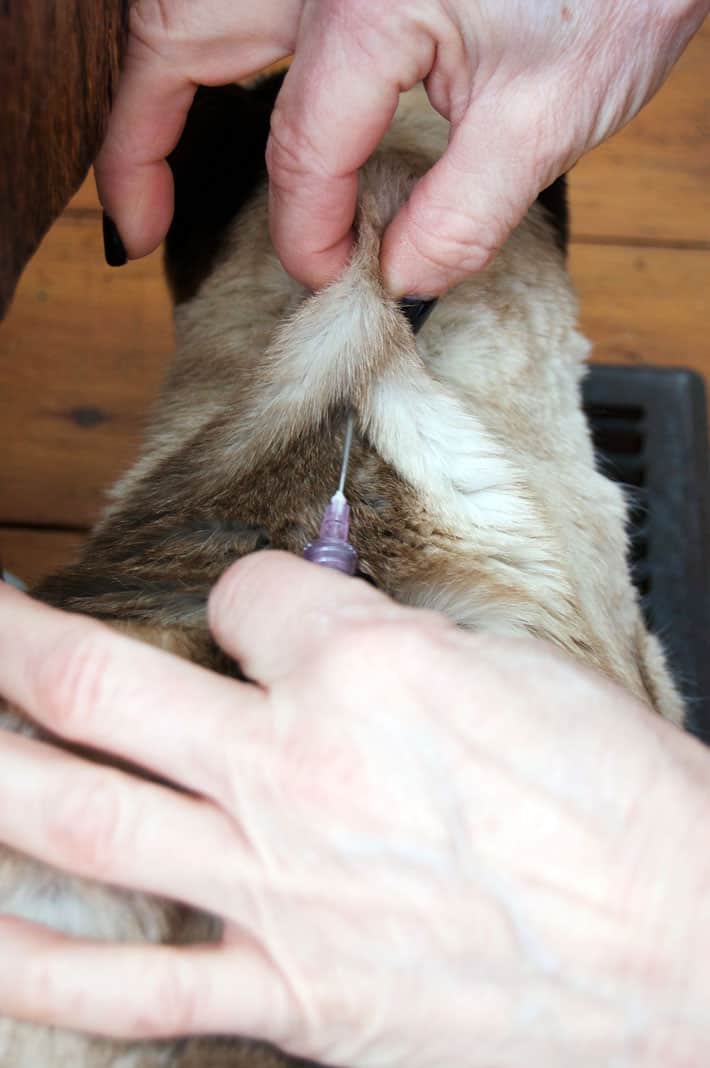
10. Release the scruff and let the IV fluids flow by rolling the wheel upwards.
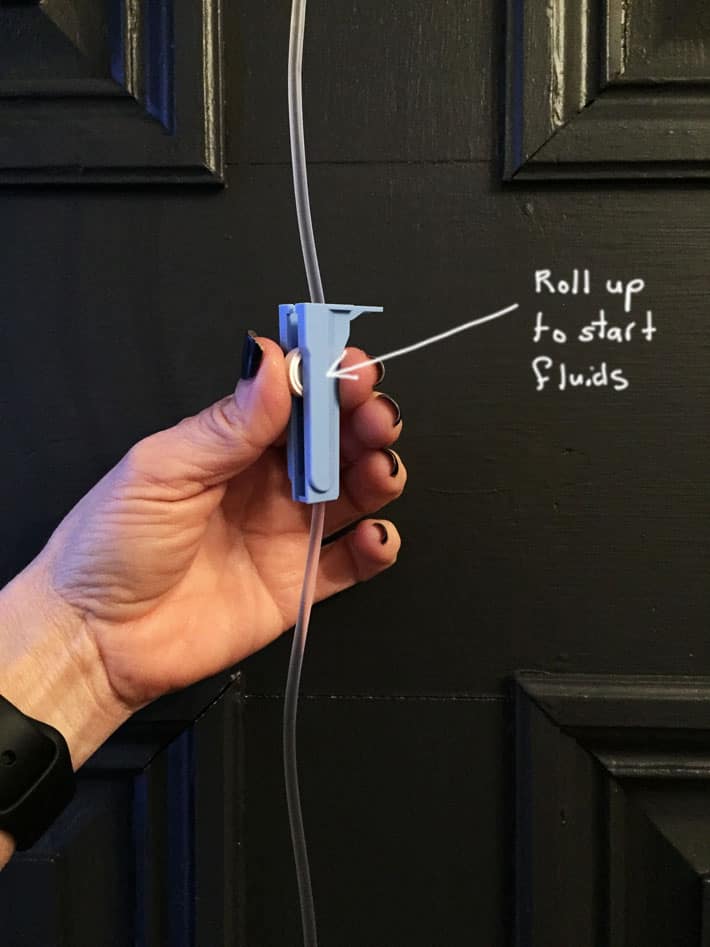
11. Pet your cat to help make the experience a more pleasant one.

12. Your vet will let you know how much fluid to give your cat but chances are it'll be 100 ml if you have an average sized cat. When injected 100 ml looks like the size of a small orange on the back of the cats neck.
13. Once enough fluids have been administered (check the size of the lump on the cats neck and the fluid line on the IV bag) you can stop the flow of IV fluids by rolling the wheel down, remove the needle and pinch the cat's skin for a minute to stop the fluids from leaking out.
14. Remove the needle by putting the protective cap back on and unscrewing it. Replace the blue protective cap to keep the line clean.
15. Everyone gets a treat! Seriously. You and the cat. Treats for everyone.
How long does it take for a cat to absorb subcutaneous fluids?
It only takes a few minutes to give your cat subq fluids but it will take them a while to absorb all those fluids.
Most cats will absorb all the fluid within a few hours. You'll know when the fluids have been absorbed when the lump of fluid where you gave the injection has flattened.
If the lump of fluid seems to move (down your cats neck, back or to their shoulders) don't worry about the migration. It sometimes happens. The fluids will still be absorbed normally.
Can you give a cat too much subcutaneous fluids?
It IS possible to over hydrate so don't immediately think if some is good more is better. It's not. Only give the amount of fluids as recommended by your vet. Too much subcutaenous fluids can cause hypertension and cats that have heart problems can develop fluid buildup in the body.
Fluid buildup in a cat with heart problems can become a medical emergency. So to reiterate; only give the amount prescribed by your vet.
What does subcutaneous fluids do for cats?
Obviously the reason for giving fluids is to hydrate the cat. For cats with renal failure, their kidneys go through more fluids than normal (the cat pees a lot). You can lead a cat to water but you can't make it drink so giving fluids under the skin is the best way to help rehydrate them.
Subq fluids provide the cat with the extra fluids they need to feel well.
- The cat feel will feel better in general (the way you do when you're hydrated)
- The extra fluids will help slow down the progression of chronic kidney disease (renal failure)
- Fluid therapy is immensely helpful for chronic constipation, a side effect of renal failure. They'll help your cat poop. And you know how much better you feel if you poop.
Need more instruction? K, here I am giving Cleo her fluids.
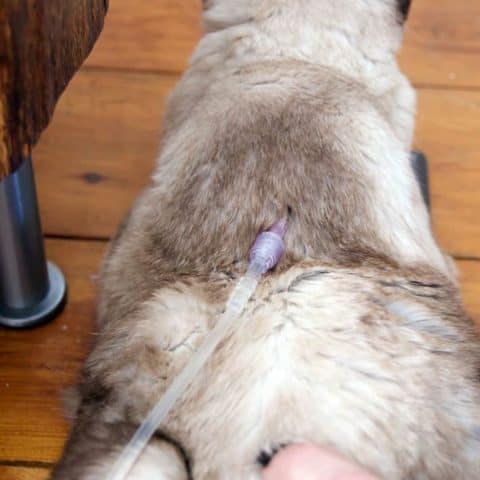
Giving Subcutaneous Fluids to Older Cats.
A step by step guide to giving your cat with chronic kidney disease subcutaneous fluids at home.
Materials
- Vet prescribed fluids
- 18-20 gauge needles
Instructions
- Hang your fluid bag a couple of feet higher than you will be with your cat. I used a coat hanger.
- Remove the cap from the end of the tubing.
- Press your needle (with the protective cap still on) onto the nub.
- Twist the plastic nut a couple of twists to hold the needle in place.
- Remove the protective cap on the needle.
- Find the open hole on the needle. This should be inserted facing up into the cat.
- Put your cat where you’ll both be comfortable. You’ll need to keep your cat in place. I like to squish her between my legs on the floor near her favourite heating vent. Other people will sit their cat in the corner of a chair or couch to keep them from squirming away. Putting them in a very small box could work as well. Cats like boxes, they feel safe in them and it would help stop them from crawling away.
- Hold the needle in your dominant hand with the hole facing up. With your other hand pull the cat’s skin up by the scruff around her shoulder blades, forming a tent.
- DECISIVELY insert the needle (with the hole side up) into the tent of skin. Don’t hesitate. The first few times it’ll be gross and scary and shocking and you’ll hear the skin crunch and all sorts of awful things. You want the needle to go in the pocket of air between the skin and her muscle.
- Release the scruff and let the IV fluids flow by rolling the wheel upwards.
- Pet your cat to help make the experience a more pleasant one.
- Your vet will let you know how much fluid to give your cat but chances are it’ll be 100 ml if you have an average sized cat. When injected 100 ml looks like the size of a small orange on the back of the cats neck.
- Once enough fluids have been administered (check the size of the lump on the cats neck and the fluid line on the IV bag) you can stop the flow of IV fluids by rolling the wheel down, remove the needle and pinch the cat’s skin for a minute to stop the fluids from leaking out.
- Remove the needle by putting the protective cap back on and unscrewing it. Replace the blue protective cap to keep the line clean.
- Give the both of you a treat. You're done.
Notes
Using a smaller needle (20 gauge) will be more comfortable for your cat but will take longer to give the fluids.
Using a larger needle (18 gauge) will be less comfortable for your cat when you insert the needle but the job will be finished more quickly.
Cats breeds prone to CKD
- Persian
- Abyssinian
- Siamese
- Ragdoll
- Burmese
- Russian Blue
- Maine Coon
How to prevent renal failure in cats
You can help reduce the chances and severity of renal failure in any breed of cat.
- Keep their teeth cleaned and cared for. Gum disease and teeth issues contributes to renal failure in cats. A lot.
- Feeding food that's high in phosphorous will increase the chances of the disease and the faster advancement of it. Feed your cat high quality food from day one. And if they're diagnosed with chronic kidney disease immediately switch them to a food made specifically for renal failure cats.
- Toxins eaten by a cat (poisons, antifreeze, pesticides) may not kill them immediately but can cause a cat to develop chronic kidney disease.
- Indoor cats have a lower risk of renal failure because of their more limited exposure to toxins.
Even knowing Siamese are predisposed to this disease, and knowing how painful it was to hear the diagnosis and eventually have her put to sleep I still want another traditional Siamese cat. Desperately.
Cleo came to me when her owners discovered they were allergic. I can't remember who they were and have no idea where they got her, but if I knew I'd have another Siamese right now.
Immediately following this treatment, Cleo got 3 Temptations treats and I got a whiskey. Cleo always felt much better a few hours after her fluids. I usually feel a bit wobbly after mine.
→Follow me on Instagram where I often make a fool of myself←
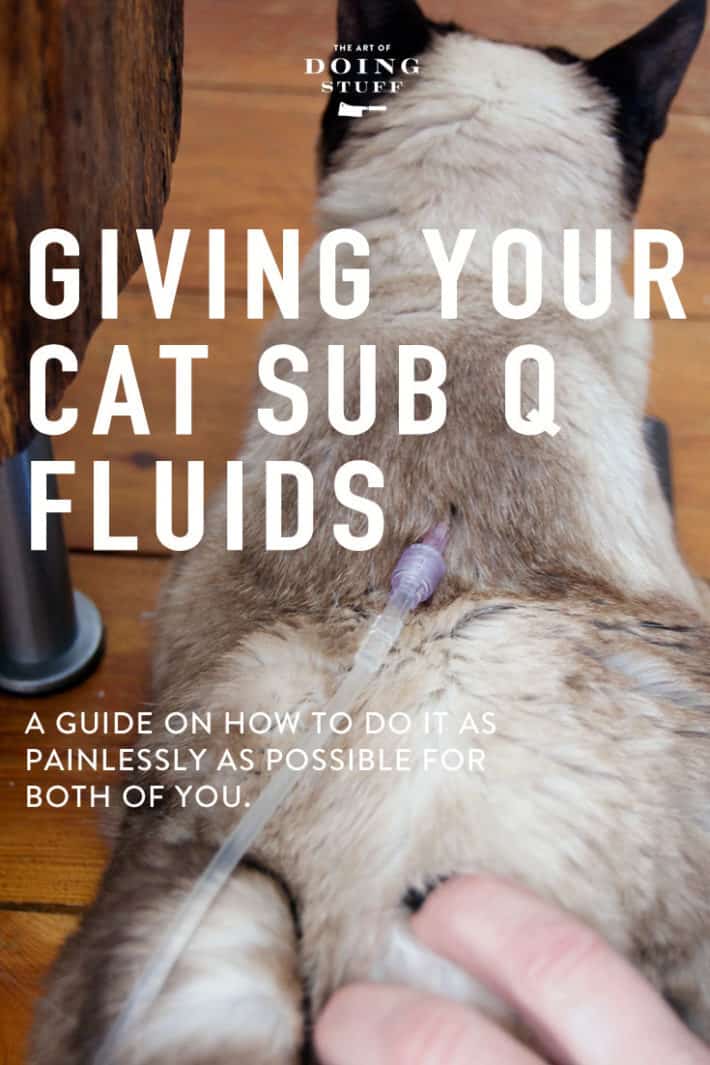

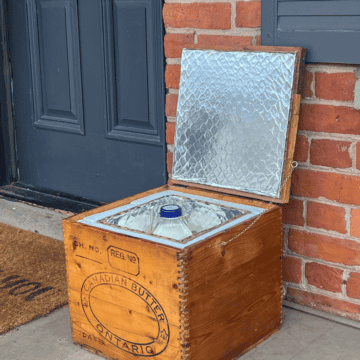
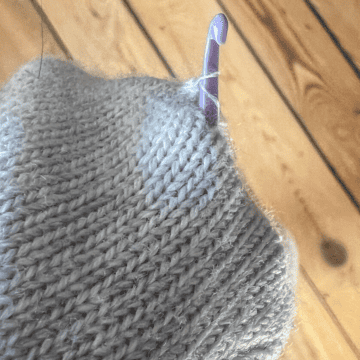


This was very helpful to know, I just took my cat to the vet and they gave her fluids, the lump definitely moved to her front right leg, I am worried the lump is not getting smaller after 8 hours and instead of feeling better she is very grumpy and won't let anyone move her. I was just wondering if I should wait or take her back to the vet.
HI Nicole. Sorry, I just got this message. How is your cat? ~ karen!
What do you do if you accidentally give too much? I did it tonight for my 15 year old cat and it was too much. And now she vomited, which she didn’t do the last time. Do I just watch her and hope that she absorbs it?
Thank you for posting this! Found your site while googling if I can give my kitty too much subq and thought I'd share. I have been giving my 16yo rescue fuzzbutt subq at home now for over three months. It was a struggle each time. I was rolling him up in a towel feline burrito style with a slit up the back, holding him with one arm, while trying in finagle the proper needle placement and fluid administration. My bestie, who used to be a vet tech, suggested I put Sir Fuzzy Britches on a towel in my deep kitchen sink. Worked like a charm. I can hold him down with one hand now...instead if fighting and the inevitable crying and feeling like a cat mom failure. I know he needs this treatment, and we both hate doing it, but I am dedicated to giving him the most comfortable life possible. Thanks for your post and you humour. (He doesn't like treats...believe me, I have tried, but tonight I got peppermint patties...😄)
Ha! Well, you deserve something too. With my cat when she was sick, bacon was the only thing she'd go for. (real bacon not bacon scented treats) ~ karen!
Thank you so much for your post: the how-to and acknowledging of the emotional part of this treatment.
You're welcome and good luck Shelley! ~ karen
Hey I was wondering if someone could let me know what it means to accidentally go through the skin when trying to administer these fluids. I read that’s a common mistake and the reason for the fluids to leak outside of the cat when the line is open (this happened to me and I was searching for the reasoning). I’m trying to figure out what exactly that means so I can avoid doing it again.
Hmm. I'm not sure what's happened. Are your fluids leaking while you're giving them or after you pull the needle out? ~ karen!
This is a great post, thank you for making it. I'm not sure how I found myself here, I think I was looking at some of your other great posts. I'm very sorry for your loss. We lost our cat to CKD last month and it was, and still is, devastating. Unfortunately, she wasn't a candidate for IV fluids at home because we adopted her at age 8 and she was likely abused by humans before she came to live with us. She was very fearful of being held or handled without her first coming to you. She would climb up the wall at the vets in a way that was extreme, even for a scared cat, and it would have been too much for her to have the added stress of regular IV treatment at home. The vets really struggled to treat her for anything without sedation every time. We lost her less than a month after she was diagnosed, and that included 2x 3 day stays at the animal hospital on IVs to help her feel better. Sadly, it didn't work. She is pain free on rainbow bridge now. I still cry when I think of her x
Hi Karen,
Thank you so much for making this post. I thought my vet was insane (i basically fainted in the office) for asking me to do this and it was really nice to see how common this actually is.
Like others, I stumbled across this post and your blog because I recently found out my 16 year old Cashew has really advanced kidney failure. The vet told me he has about 4-6 months left IF I give him fluids every day for 2 weeks and then possibly every other day after the 2 weeks.
Today is day 5 and he just will not cooperate. I've tried 3 times today and every time he grew more stressed which is painful to see. He hates the kidney support food the vet gave me and is barely eating anymore. I'm so conflicted with wondering if I am selfish for trying to keep him alive for only 4 months or am I selfish if I do not try to reach the 4 months.
I hope to find some clarity soon.
Hi Crys. I'm sorry you're having such a hard tie. I know that it's terribly stressful. I can tell you that when I finally had Cleo put down it was because one night she simply couldn't walk. It was as though she'd become paralyzed or had a stroke. It was awful. And I will forever regret not having had her put to sleep sooner. The problem is - you just don't know when that point is and you also don't want to put them to sleep too early. :( My cat also hated the kidney food. At this point there is NO reason to stress her out by trying to feed her food she hates. Give her what she likes to make sure she eats. Give him a day or two to calm down from the fluid stress and try again. Good luck, I'll be thinking of the both of you. ~ karen!
My cat is 18+ and I have been doing this almost 2 years and though I feel her time is getting closer she still climbs into bed in the middle of the night, snuggles up and purrs away. I do a few things not mentioned I'll share. First when my vet was going to show me how to do it I said no, give my instructions and I'll do it in front of you. Gave me confidence from the start.
Having a dedicated spot set up really helps. I do it in my unheated sun room even though I'm in CA it's easy to heat the fluid in winter by filling a crock pot with water and put the bag in of course (not where the line goes into the bag) and heat just a little. I use #18 needles and rotate once the needle is in to get max flow. I do 200ml 3 times a week so I mark the bag at 2,4,6 and 8 with a blue or red sharpie so it's easy to glance up and see where I'm at. My vet said it was OK to use one line for 2 bags so I put a #1 or 2 on the bag. I change the needle right before I do it, I'm 65 and have so much going on it's easy to get distracted so if I change it right before I do it I never screw up. I give her treats the hole time which isn't very long at max flow. Have some extra needles, I've pricked my own hand then you want to use a new sterile needle. Seriously the worst part is the increased times you'll have the clean the litter box.
Ah... this just came up in my email. And brought me back to the 6+ years (!) we did this with our Lynx point Siamese, Lily, that we adopted from the local Humane Society.
We started out doing infusions every other day, but after a couple years, it moved to every day. She was a beautiful cat, and on her special diet and fluids did quite well, until she didn't. When it's time, you know, and most likely there were other organs starting to shut down... who knows. I was a regular visitor to the local Vet school for supplies which probably saved us some money, but once you start on this journey there is no way to know how long you'll be sticking needles in your pet. She tolerated it very well, although you could tell her skin was getting kind of beat up from so many holes.
Not everyone can do this, some folks take them to the vet to have the infusions, some cats only last a month or two. But we traded off going out of town on trips together for a few years so we could have her longer.
One saving grace was that we had a traveling vet who only did house calls. When it was time to say goodbye, she came to our house, I held Lily in my lap as she went under. .....but we have been pet-less since. Maybe I just don't want to go through that again.
Kind of prepared me to be a hospice volunteer though.
6 years, wow! That's impressive for both of you. Good job. ~ karen!
Ahhhh yes, the giving of subcutaneous fluids. Two cats, one dog experience with this. Giving fluids certainly gave my pets a better quality of life until it didn't. With my lovely, sweet cock-a-poo, giving fluids over time went from monthly to twice a week and when we were looking at daily, the stress became too much for both of us....it was time... By giving fluids, life expectancies were increased anywhere from 1 1/2 to 2 1/2 years. A good informative post Karen, thanks.
Good work on giving your pets fluids Lin. It takes commitment. ~ karen!
We had to do the same thing. It is hard at first. Our little cat sat perfectly still while the vet trained us how to do it the first time. After that she was all claws, feet and screaming. Wife had to make a cat bag so we could get her done. She would sit still for my sister whose a nurse and had done her cats before. She had 1 1/2 great years with us before we had to.....
Anyway, learn to do it, you won't be sorry. Also if your vet will not give you a prescription where you can by the fluids from a vet supply online, find another vet.
Sorry about your cat Dave. But good for you for taking the steps to help her feel better for another year or more. ~ karen!
Thank you all for your encouraging words. I have just given my little Russian Peterbald cat his 2nd treatment at home. Honestly I didn't think I could do this but so desperately want to improve his quality of life and hopefully extend his life as well. I can't tell you how much more confident I am after reading this article and the other comments!
I'm so glad I stumbled upon this. I makes me feel all that more confident.
I really wonder and would like to know if I could use a 1/2 inch length needle? Our vet hasn't been very helpful and cooperative in our sweet Pumpkins process. They kinda were like this is what you need to do, and now you are on your own good luck. I had to order a box of needles however the longer needles make me so nervous of poking through the skin or hitting bone.. I'd feel so much more at ease if I could get away with a shorter needle for his fluids and vitamin B12 subcutaneous injections.. He has a 3rd treatment that's also in the form of subcutaneous injections..
And had anyone experienced shooting the needle in and then feeling a barrier.. Today is only my 3rd time shooting a needle and a felt a bit of resistance. The needle wouldn't go further in. Did I hit bone?
How do you know how much fluid the cat is getting ?
Hi Anna! You have to watch the bag. You can see how much is out of it by the lines on it. But as you get used to doing it, you know when to stop just by the feel of the size of the ball of fluid on the back of their neck. :) ~ karen
Often times I give my cat fluids and there's not much of a bump, if any, is that normal?
HI Rachel. There definitely should be a bump. Are you watching to see how much fluid is coming out of the bag? The two reasons I could see for not having a bump are you either aren't injecting into the right spot (either too deep and into muscle, which you do not want to do, or you simply aren't allowing enough fluid to go in). Again, I am NOT a vet and you should definitely check with your vet. But those are the two issues I would think might be the reason behind it. ` karen!
Hi, I also just started the Sub Q fluid for my cat, I followed the instructions and I also don't see the bump neither . The dosage is only 75ML once a day which is not a lot... I don't see any fluid leaking out.. Everyone says there should be a bump and I just don't see it. Anyone else have similar experience?
thank you very much
I rarely saw a bump and my cat clearly was doing well so I know the fluids were being properly administered. My 21 year old female received sub Q fluids and B12 for 7 months. She did quite well and enjoyed her life right up to the end.
Right now I am dealing with giving fluids to an elderly cat with very thin skin. It's so hard to get it under her skin so that it doesn't leak out and/or goes through to the other side of the skin. I wish I could figure out how to make sure it gets in and doesn't leak out.
I often encountered the same problem. needle poking out the other side. Try not pulling the skin so it's too taut therefore, leaving a space wide enough for the needle to easily travel. Keep the needle close (and parallel) to your cat's body, again providing the widest space for the needle to enter, hopefully minimizing the risk of outbound punctures. It is definitely tricky. It sometimes took me 3 tries (many days I got it the first try). The very first time, i inserted the needle, it went in, then out through the other side and into my finger. Just stay calm, take a couple of breaths, pet your kitty, don't make a big deal of it and try again. You can do it then afterwards you both get a treat.
I keep the needle in after I'm done for a few minutes while the fluids migrate. To speed up process, I massage the skin lightly & gently pull it up so it will move away from where he was injected. That keeps all the fluids in my little boy.
Karen, you are terrific for posting this. Is it possible for you to add to the original post that warming the liquid to cat temp can make all the difference in application? It's HUGE.
Cheers!
You're right! I always kept my fluids in my laundry room with the door closed (which made it a warm room) so the fluids were warm. ~ karen!
I’ve been giving my cat fluids by myself for a while and looked at this post in case I might pickup any hints.
Here’s my two cents—
•I always change it to a fresh needle when we finish with fluids so will be ready to go the next time.
•I had a hard time seeing how much fluid I was giving so I decided that when my cat ran out of patience, he’d had enough. (I didn’t want to make it any worse—in his opinion—than it already was.)
•Feeling the size of the lump of fluid-whatever under his skin, I don’t think that’s too far off.
•“We” use a circulating cat fountain to encourage hydration. (He won’t carry a water bottle &/or kept spilling it)
•My vet has prescribed Hills Science Diet K/D. I keep a dish of dry available just-in-case, but mainly serve canned:I’m pretty sure only pâté comes in larger size can, and stew— chicken and vegetable or tuna and vegetable, comes in teeny cans. (Of course, “we” only eat tuna and veg stew)
Hope this helps someone.
My cat is old and has very thin skin. It is difficult to know where to put the needle in him. How can this be done more easily.
It's tricky administering sub q fluids to an old thin cat. I am searching for tips on this. Lately, it takes me 2 or 3 tries to position the needle under the tent properly instead of through like I'm sewing. It's hard but I'm patient and I get the job done. I'm just wondering if anyone out there has some wisdom.
I just want to cry! I began this at hm. a mth. ago. I thought I finally got the right amt. in him but then when i picked him up out of his carrier, ( he was used to the Vet tech.leaving him in there when they did it), & he'd try to run away from me. Anyway I was SOO happy, then picked him up only to find it was soaked under all the blankets & he hadn't gotten ANY of it! The needle goes thru his super thin skin , plus he's SOO bony like yours, there's barely enuf skin to pull up to tent. Did you find a solution? jenyelli@gmail.com
Try lessening your pull when you pull up the scruff of skin to make the tent. I believe if her skin was pulled too taut, it made the channel of space so narrow, the needle ended up poking out of the sides. Try to keep the needle close to her body (but parallel) so that the needle has a wide amount of space to enter. You can try different spots behind your cat's neck to the middle of his back. Stay calm. You can do it. It never took me more than 3 tries.
I wish I'd seen this back in 2016, when I was supposed to give my cat subQ fluids at home. Despite me doing all the things you (and her vet) said, and already being experienced with shots, she was a squirmy little brat and fluids-at-home never worked out. But I really appreciate your post, which I found while searching for feline vitB posts (I saw that first), since another cat now gets those. I was confused because he was at UrgentCare yesterday and they inject the B12 into a muscle, rather than subQ, and his MIRACULOUS recovery caused me to wonder if I'd been doing it wrong all this time. I haven't.... yay... but if vet visits are going to cause such wondrous reactions (he's eaten more in the last 24 hrs than in the last 2 weeks combined!), then I'll pay for the dang vet visits!!
My Mooch was just diagnosed with CKD and since I am on a small pension and she freaks out every time she even sees the carrier I asked the vet to show me how to give subcutaneous fluids. My first times was a disaster. Not so much the giving but the not being able to see how much the fluid had gone down and into my Mooch. It's so hard to see. Do you have any suggestions on how to make is easier? If you have an 18G the needle, fully open with the bag hanging high, how long, approximately should it take? The vet was not very helpful, just old me it doesn't matter since the cat will get rid of everything she doesn't need but as I said before, my budget is limited and I would prefer not to waste any of the fluid but just give her what she needs. She is 13, was an abused and abandoned little cat and deserves the best I can do for her. Any advice would be greatly appreciated. Thank you.
Hi Gigi - I’m doing this now for an 18 year old cat. The fluid bags have 1000 milliliters. There are numbers and lines on the bag, marking off every 50 and 100 mL. Your vet will tell you how much and how often. So, if the bag is full and you’re to give 100 mL per treatment, you’d go down to the number 1 on the top and then the next treatment go down to the number 2 - etc. if you’re to give 150mL - you’d go down to the dash between 1 & 2. Then the next time you’d go to 3. Make sense?
My cat, Jiggy, had renal failure and I had to do this for him every few months for a week or so. He lived a long happy (albeit sickly) life. In the end, he just lost too much weight and could barely make it onto the bed. I laid down with him and started crying knowing I was going to have to put him down (he got me through some tough life times) - he reached out his paw and put it on my face as if to tell me that it was ok and he was ready. I still dream of that sweetpea. I would have given him subcutaneous fluids every day if I had to.
Anddddd that made me cry. I stress every single day about Cleo and the day I'll have to put her to sleep. ~ karen!
Oh, this takes me back....my vet detected chronic renal failure in my cat Zach when he was about 17, and she suggested a three-pronged approach of a prescription diet, a supplement, and the subcutaneous fluids. The prescription diet was no problem (Zach would eat literally anything, and had the appetite of a Clydesdale horse), the supplements were no problem (I stuck each pill in a pill pocket and he would snarf them down in seconds), but...he fought me HARD on the subcutaneous fluids. And when Zach fought hard, he fought HARD (during one of his vet visits, he actually literally BEAT UP HIS VET).
After about two weeks of struggling, fighting, scratches, yowls, shouts, and sweat, it finally hit me that "if he has the energy to fight me THAT much, that may be a sign that he is actually okay without the fluids right now". So I quietly decided to simply observe him, and give him fluids if it seemed like he needed them (if his energy dipped or he seemed to get getting logey). He never seemed to need them, and at his next vet visit the vet said that his urinalysis looked a lot better - thanks to the prescription food and the supplements - and that was that. He ultimately passed away at the age of 18, and at the time of his death his urinalysis showed his kidney function as "normal".
Hi Kim,
Can I ask what was the prescription diet and supplement you had your cat on? Mine is 17 and she’s fighting me on fluids at home. My vet charges $35 each time I go in which should be every three days or so...
I would only hope I could have the same situation you did. She’s a picky eater though so I’m not sure this would even work
Thanks,
Amandal
Hi, I don't know what Kim used but I use Royal Canin Veterinary Diet Renal Support A Dry Food and the supplement is Vetoquinol Epakitin supplement for dogs & cats on my cat. You can find them both online at chewy.com but the cat food you need a prescription.
Also, what I did is left a faucet open all the time so she can drink as much water as she wants. That idea actually save me hundreds of dollars. Don't worry if you leave only a thin drip you won't get a increase in your water bill. It is all worth it.
Per your FB request, I, too, have no problem viewing the video. Using an iPad.
Thanks Lori. I think we finally got it figured out. :) ~ karen!